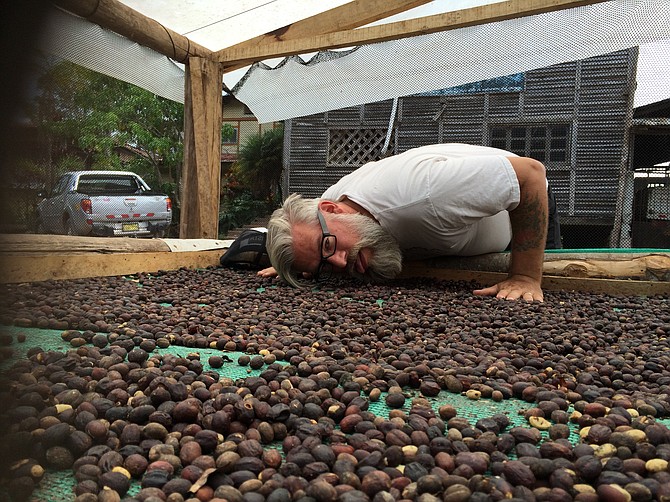 Facebook
Facebook
 X
X
 Instagram
Instagram
 TikTok
TikTok
 Youtube
Youtube

"My Spanish is terrible," admits Andy Newbom. Nevertheless, the 13-year coffee professional has co-authored a new book titled Coffee Spanish for Coffee Buyers, a field guide intended to help coffee buyers, roasters, baristas, and coffee aficionados navigate the widely different terms employed in each of the dozen coffee-producing nations of Central and South America.
"You won't learn Spanish from this book," Newbom adds. "Not even close." Nonetheless, the book offers country-specific translations for the equipment and methods used by local coffee growers and processors. Since most of these countries developed their coffee industries independently, they've each developed their own idioms — words that can be as confusing to each other as they are to American coffee buyers.
"They're not from Spanish," he points out. "They're transplanted words. So they tend to be slang, or half made-up words, or a feeling about what a machine does — or a half-German, half-English, half-Spanish word — but they're not really true Spanish words, and they're not translations."
Even within the same country, terms may vary. For example, in Veracruz, Mexico, a huller (which removes the hull, or parchment, from coffee beans) will be referred to as a demolidor, which directly translates to demolisher. Elsewhere in Mexico, Newbom says, they might call it a morteador — usually used to mean murderer.
Newbom and his wife Nanelle (until recently the head roaster at Swell Coffee) took over a Bay Area roasting shop in 2003 and formed Barefoot Coffee, which they sold in 2010. From there they embarked on a two-year stint to El Salvador where, among other things, they established the country's first craft brewery.
While in Central America, Newbom also began to gain a greater familiarity with working with coffee at origin. While his wife knew enough Spanish to hold conversations, when it came to discussing coffee practices, she didn't share the vocabulary. Newbom, on the other hand, started to pick up the lingo. "I have a very inquisitive, sort of questioning mind," he explains. "I tend to want to know technical terms."
As he visited other countries, his use of these terms would be met with blank stares, and the differences began to stand out. "I realized there was like this other language," he recalls. "I would go to Guatemala and I would use those same phrases and they didn't work. Then I went to Peru, and almost all the words are different."
Currently the director of coffee for IP Coffees, which imports high grade coffee from Mexico, Newbom enlisted the help of Andrew Russo, a Portland coffee consultant and author of Coffee Taster's Compendium. They designed the book to cover the basics of coffee-grading and processing, and have translated their respective phrasing throughout the different Spanish-speaking landscapes, in addition to a little Portuguese for Brazil. The self-published book is already available as an e-book, and releases in print the first week of August.


"My Spanish is terrible," admits Andy Newbom. Nevertheless, the 13-year coffee professional has co-authored a new book titled Coffee Spanish for Coffee Buyers, a field guide intended to help coffee buyers, roasters, baristas, and coffee aficionados navigate the widely different terms employed in each of the dozen coffee-producing nations of Central and South America.
"You won't learn Spanish from this book," Newbom adds. "Not even close." Nonetheless, the book offers country-specific translations for the equipment and methods used by local coffee growers and processors. Since most of these countries developed their coffee industries independently, they've each developed their own idioms — words that can be as confusing to each other as they are to American coffee buyers.
"They're not from Spanish," he points out. "They're transplanted words. So they tend to be slang, or half made-up words, or a feeling about what a machine does — or a half-German, half-English, half-Spanish word — but they're not really true Spanish words, and they're not translations."
Even within the same country, terms may vary. For example, in Veracruz, Mexico, a huller (which removes the hull, or parchment, from coffee beans) will be referred to as a demolidor, which directly translates to demolisher. Elsewhere in Mexico, Newbom says, they might call it a morteador — usually used to mean murderer.
Newbom and his wife Nanelle (until recently the head roaster at Swell Coffee) took over a Bay Area roasting shop in 2003 and formed Barefoot Coffee, which they sold in 2010. From there they embarked on a two-year stint to El Salvador where, among other things, they established the country's first craft brewery.
While in Central America, Newbom also began to gain a greater familiarity with working with coffee at origin. While his wife knew enough Spanish to hold conversations, when it came to discussing coffee practices, she didn't share the vocabulary. Newbom, on the other hand, started to pick up the lingo. "I have a very inquisitive, sort of questioning mind," he explains. "I tend to want to know technical terms."
As he visited other countries, his use of these terms would be met with blank stares, and the differences began to stand out. "I realized there was like this other language," he recalls. "I would go to Guatemala and I would use those same phrases and they didn't work. Then I went to Peru, and almost all the words are different."
Currently the director of coffee for IP Coffees, which imports high grade coffee from Mexico, Newbom enlisted the help of Andrew Russo, a Portland coffee consultant and author of Coffee Taster's Compendium. They designed the book to cover the basics of coffee-grading and processing, and have translated their respective phrasing throughout the different Spanish-speaking landscapes, in addition to a little Portuguese for Brazil. The self-published book is already available as an e-book, and releases in print the first week of August.
Comments